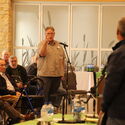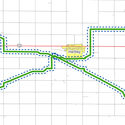Navigator outlines pipeline plans in O'Brien County
Line would intersect SW of Hartley
December 9, 2021

NICK PEDLEY/SENTINEL-NEWS
Several local landowners turned out to ask questions and express concerns about the proposed Heartland Greenway pipeline during an informational meeting Dec. 1 at the Crossroads Pavilion in Sheldon.
The details of a proposed pipeline that would cross portions of both O'Brien and Clay counties became a little clearer last week.
Representatives from the Iowa Utilities Board (IUB) and Navigator CO2 Ventures LLC held an informational meeting Dec. 1 in Sheldon. The presentation outlined the intent and scope of the Heartland Greenway pipeline, which would carry liquid CO2 from ethanol and fertilizer plants in five Midwest states to an underground sequestration site in Illinois.
Locally, the pipeline's route would extend 63.21 miles in O'Brien County with a conversion point southwest of Hartley. In Clay County, a total of 32.45 miles of pipe will extend across two stretches of land in the northwest and southwest part of the county.
The goal of the pipeline is to reduce CO2 emissions at its partner facilities, in turn making products like ethanol more environmentally friendly by reducing atmospheric greenhouse gas emissions during production. Representatives from Navigator noted slashing emissions for ethanol would lead to a stable long-term outlook for the industry as the world transitions to more carbon-neutral sources of fuel.
"The ethanol of a decade ago is not the ethanol of today. It's continued to improve and get better," said Elizabeth Burns-Thompson, Navigator's vice president of government and public affairs, during the meeting in Sheldon. "Adoption of technologies like [carbon capture and storage] are what's going to help that product evolve and continue to get better in the years to come."
• Footprint and finances
If built, the Heartland Greenway pipeline would traverse 1,300 miles in Iowa, Minnesota, Nebraska, South Dakota and Illinois. The biggest footprint would be in Iowa, with 900 miles of pipe stretching across 36 counties in the Hawkeye State. It would link 20 receipt points and transport up to 15 million metric tons of liquid CO2 each year. The project is commercially anchored by Valero and financially backed by BlackRock. Locally, Valero's ethanol plant in Hartley would be connected to the line.
Burns-Thompson explained facilities that are hooked up to Heartland Greenway would pay a per-tonnage fee to Navigator for the amount of CO2 they put on the line. The facilities would then get to keep federal emissions incentives and other benefits associated with their decarbonization efforts, whether that's in the form of a tax credit or something else.
"At the end of the day, the goal is to decarbonize these operations," said Burns-Thompson.
Navigator representatives also touted the project's economic impact, which would be worth $1.6 billion in Iowa alone. The company estimates that the pipeline would create 50 permanent jobs and 5,000 construction jobs. Overall, Navigator estimates the pipeline would result in $25 million worth of property taxes in Iowa.
• How it works
Burns-Thompson said that while carbon capture and storage (CCS) may be new to some, it's been around for several years.
The process begins when CO2 emissions are captured at ethanol and fertilizer plants with special equipment that dehydrates the gas and compresses it into a liquid form. Once in a liquid state, the CO2 is placed in the pipeline and sent to the storage site in Illinois.
The sequestration site requires special geologic formations that are only located in certain spots throughout the country. In this case, the Mt. Simon sandstone formation has been determined to allow for "safe, secure and permanent" CO2 storage. The liquid CO2 will be injected more than 6,400 feet into the ground – over 3,300 feet deeper than the deepest water source. It will then be held in place by cap rock and left to solidify over time.
Noting figures from the Iowa Department of Natural Resources, Burns-Thompson said the pipeline would remove the equivalent of approximately 30 percent of Iowa's commercial, residential and industrial process emissions on any given year.
"Is this everything we need from an environmental perspective? No. But does it help make progress? Absolutely," she said. "This project can have some substantial impacts and help us make progress towards those goals that we've set as an industry, as a state and as a society as a whole."
• Easements, land use compensation
Land use was a main topic of last week's meeting.
Though Navigator's representatives said the company's priority will be locking up voluntary land easements to build the pipeline, it will utilize eminent domain procedures if the IUB grants the project public use status. Since the meeting in O'Brien County has been held, the company can start negotiations with landowners immediately. Clay County's meeting is Dec. 13.
Burns-Thompson explained that initial offers for easements will be estimated from market surveys done by a third party.
"One thing about this is our commitment to being collaborative and negotiating in good faith, not only throughout this stage in the process but throughout the lifetime of the project as a whole," she said. "That means acknowledging that no two parcels are created equal, no two farms are the same, no two farmers are the same and no two tenants are the same. We want to provide and have the opportunity to treat those with the unique circumstances that they are due."
The property use agreements will be a non-exclusive permanent easement for a 50'-70' wide tract of land spanning the length of the line's route through an individual property during construction and 50' after the pipeline is built. Twenty percent of the easement agreement will be paid after the deal is signed, with the remaining portion fulfilled prior to construction.
Burns-Thompson said Navigator wants to have an open line of communication with landowners to optimize the route so that in the end "we can have something that works best for all involved."
"This is meant to be a negotiation," she said.
• Crop losses, tiling damage
The use of farmland will also necessitate crop yield loss payments to landowners in the pipeline's corridor.
Navigator is offering 100 percent yield loss compensation in Year 1, 80 percent in Year 2 and 60 percent in Year 3. Damaged drainage tile will also be repaired after construction, and landowners will be allowed to use the contractor of their choice.
Navigator plans to assess and locate field tile with each landowner prior to construction, with the overall goal of avoiding and mitigating potential damage. Disturbed or damaged tile will be repaired and tied back into the system.
Burns-Thompson said Navigator's mantra with field tile damage is to "repair, replace and compensate."
Some landowners in attendance at the meeting were concerned tile damage wouldn't show up for several years. In a dry year, they noted it's impossible to tell which tile is broken and which isn't because it isn't being used.
"This is your land," said Burns-Thompson. "Part of being good stewards of it, means acknowledging that and treating it with the utmost respect."
• Safety
The pipeline will range in width between 6"-24" and be buried a minimum of 5' underground. As far as safety, Burns-Thompson said Navigator will have 24/7 monitoring of temperature, pressure, flow and redundant communication systems to monitor safety. She said valves located along the line would have the ability to shut off flow "in matter of minutes."
As far as the environmental impact should a leak occur, CO2 is an asphyxiant at concentrated levels and possesses a risk if it were to come in direct contact with humans or animals. Any leak would eventually evaporate into the air without long-term repercussions to the ground where the outflow occurred, according to discussion at the meeting.
Some individuals expressed concern that the pipeline comes close to concentrated population centers like Hartley. Navigator reps said the risk of a leak is low.
"We do acknowledge that there are risks associated with anything and everything, especially projects of this scale," Burns-Thompson said. "We do believe we're proactively mitigating many of those risks through a number of the steps we have outlined."
• Timeline, comments
County-level informational meetings will continue through January, with a projected IUB petition filing to come in May of 2022. Route adjustment from landowners, stakeholder feedback and easement acquisitions will be ongoing starting in the second quarter of 2022 through the first quarter of 2023.
Construction is expected to commence during the first half of 2024 with phased start up and commissioning coming at the end of 2024 through the first half of 2025.
All comments and questions at meetings are informal and are not entered into the official IUB record for the project. Written comments or objections to the pipeline can be filed electronically using the IUB's Open Docket Comment Form, by email to customer@iub.iowa.gov, or by postal mail to the Iowa Utilities Board, Attn: Docket No. HLP-2021-0003, 1375 E. Court Ave., Des Moines, IA 50319.





